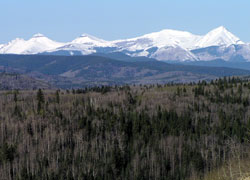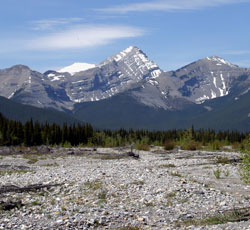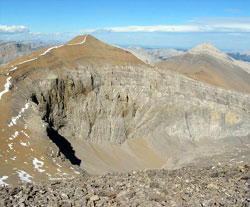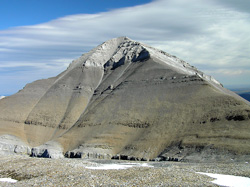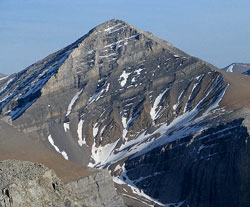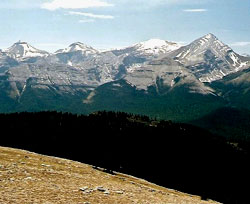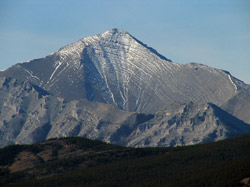
Photo: Mount Glasgow from the northeast on Hwy. #66 (Mount Cornwall beyond at left)
Mount Glasgow
- 2935 m (9,630ft)
- First Ascent
- Naming History
Located between the Little Elbow River Valley and the Elbow River Valley
Province: Alberta
Park: Kananaskis
Headwater: Bow
Major Valley: Elbow
Visible from Highway: 66
Ascent Party: Arnold Choquette
Named for: HMS Glasgow was a battle cruiser which fought in the Battle of the Falkland Islands during WW I.
Mount Glasgow, together with Mount Cornwall, Outlaw Peak, and Banded Peak form a small range which lies between the Little Elbow River to the north and the Elbow River to the south. For some reason this group seems to attract falls of early and late season snow. Often in the late spring and early summer, where rain has fallen on nearby mountains, this group will be white with fresh snow. The late summer often sees this phenomenon as well. Mount Glasgow is one of the most distinctive peaks seen from the prairies in the Calgary area. In 1792, Peter Fidler, the first non-native to visit southern Alberta, took bearings on this easily identified peak as he travelled across the prairies near present-day Calgary and south to the Highwood River. In his journal he wrote of, "a remarkable high cliff, very much resembling a Pyramid -from which very near resemblance I shall call it by that name." This is the first instance of a non-native naming a peak in the Canadian Rockies. However the name was not used by later visitors presumably because it was not noted on any map which Peter Fidler might have made. *Peter Fidler was also the first non-native to enter the Rockies and to climb one. The Marquis of Lorne sketched this group of four peaks during an ambitious, cross-country trip he made during his years as Governor General of Canada (1878 - 1883). He was married to the fourth daughter of Queen Victoria, princess Louise Alberta. The province was named in her honour as was Lake Louise. Another interesting connection is that an etching of the Marquis's sketch was made by Edward Whymper who was an engraver by trade at the time. After an interest in mountains was aroused, Whymper went on to lead the first ascent of the Matterhorn in 1865. He made several visits to the Canadian Rockies during the first decade of the twentieth century. Whymper's engraving appeared in "Canada's Pictures," the book which the Marquis wrote about his trip. When viewed from Calgary, Mount Glasgow is an attractive Pyramid-shaped peak (Peter Fidler's name was most appropriate). After a snowfall the faces are often completely snow covered. Richmond Road, in southwest Calgary, is oriented in such a way that Mount Glasgow rises in the distance. Arnold Choquette''s ski ascent in 1949 was the first recorded ascent of Mount Glasgow. THE BATTLE OF THE FALKLAND ISLANDS Mounts Cornwall and Glasgow are two of over a dozen peaks in the Kananaskis area named after British warships of World War I. Most were ships which had participated in the Battle of Jutland in 1916, but HMS Cornwall and HMS Glasgow were both cruisers which played a significant role in the 1914 Battle of the Falkland Islands. German naval forces had been raiding commercial shipping in the south Atlantic and a much larger Royal Navy formation was dispatched to the area. The battle, although not a complete victory, freed Britain''''s trade and troop transport routes in that part of the world from the threat of surface raiders for the duration of the war. The Cornwall and Glasgow, together with HMS Kent, were pursuing three German warships that were trying to escape the main battle and seek refuge in Tierra del Fuego. Choosing to concentrate their attention on the German light cruiser Leipzig, HMS Glasgow engaged first, attempting to slow down the fleeing German ship and allow the Cornwall to catch up and assist. The Glasgow suffered some hits but the tactic was successful and soon HMS Cornwall came into range and, as her captain wrote, "Cornwall hit the Lepzig''''s foretopmast and carried it away, turned to starboard, and I poured in my whole broadside." The two English ships then engaged their wounded quarry from opposite sides, their fire becoming more and more effective as they slowly closed the range. Out of ammunition, the Leipzig fired its last two torpedoes but the British had by then retreated out of range. They then re-approached the Leipzig to see if the Germans had "struck her colours," but since her ensign was still flying, opened fire once more. Her flag still flying, the Leipzig heeled over to sink rapidly by her bows. The British ships could rescue only 18 of the 286 sailors and Captain Ellerton of HMS Cornwall, "regretted that an officer as gallant as Captain Haun of the Leipzig was not one of them." THE PYRAMIDS OF THE CANADIAN ROCKIES There are at least seven mountains in the Canadian Rockies that have been known as "Pyramid." Only two officially carry the name, a third having had the name removed in order to avoid confusion with the other "Pyramids.” Peter Fidler was the first European to enter the Canadian Rockies and the first to name a peak. He noted in his journal on December 7, 1792 that he saw a, “remarkable high cliff…very much resembling a pyramid –from which very near resemblance I shall call it by that name.” He measured bearings to the feature and used it to calculate his position. It is likely that he was referring to what we now know as Mount Glasgow in the headwaters of the Elbow River. While travelling in the Bow River Headwaters near White Man Pass in 1845, Catholic priest/explorer Pierre-Jean De Smet wrote, "The valley is bounded on either side by a succession of picturesque rocks, whose lofty summits, rising in the form of pyramids, lose themselves in the clouds." On his map he noted only one of these, naming it "The Pyramid." This must have been the peak now known as Mount Assiniboine. The best known of the "Pyramids" is located nine kilometres north of Jasper. Its near-perfect triangular shaped profile when viewed from the east must have impressed James Hector of the Palliser Expedition who named the mountain in 1859. Although the mountain's slopes from this angle are similar to those of the Egyptian pyramids, the peak lacks the three-dimensional aspect that a true pyramid requires. Mount Chephren was originally named Pyramid Mountain by Norman Collie in 1897. At the same time he named its neighbour, which was covered in snow, White Pyramid. Pyramid Mountain, in contrast, had very little snow. In 1918 the Interprovincial Boundary Commission decided that Pyramid Mountain's name must be changed in order to avoid confusion with the Pyramid Mountain near Jasper. J. Monroe Thorington, a prominent mountaineer and author of the era, liked the association of the peak with the pyramids of Egypt and recommended the name Mount Chephren. Chephren, or Khafre, was the fourth pharaoh of the Fourth Dynasty of Egypt and built the second of the three Great Pyramids. White Pyramid's name was thought to be different enough from the Pyramid Mountain near Jasper and that name was retained. In 1892, Arthur Coleman named the fourth highest peak in the Rockies “Pyramid.” It was subsequently renamed Mount Clemenceau by the Interprovincial Boundary Commission in 1919 after Georges Clemenceau, the President of France during the final years of the First World War. Mount McPhail, in the upper Highwood Valley, was known locally as "The Pyramid" until it was officially named by the Boundary Commission in 1918. The surveyors at that time were influenced by the number of Canadian casualties during the First World War and named the peak to honour N.R. McPhail, a member of the Surveyor General's staff, who was killed in action in 1917. Of the seven mountains that have carried the name "Pyramid," Mount Glasgow, Mount McPhail, and Mount Assiniboine are the closest to the correct three-dimensional shape when viewed from the appropriate angles, but they are among those that never, officially at least, have carried the name.
